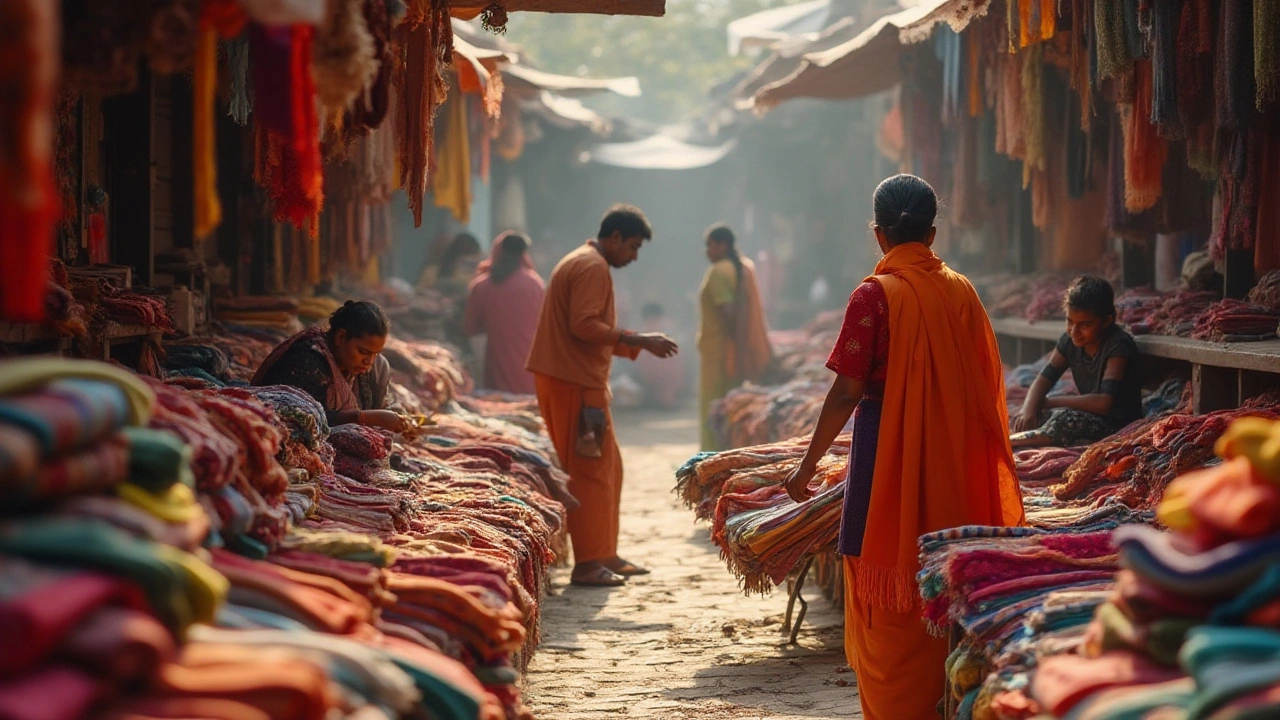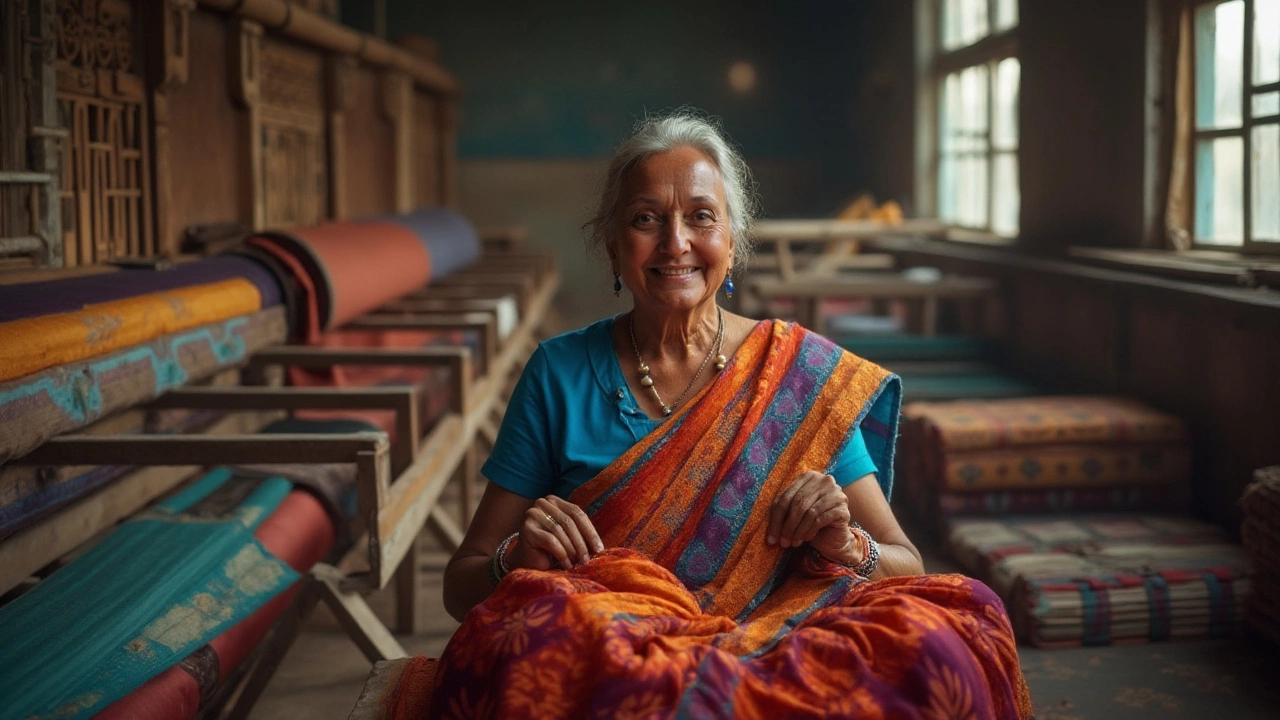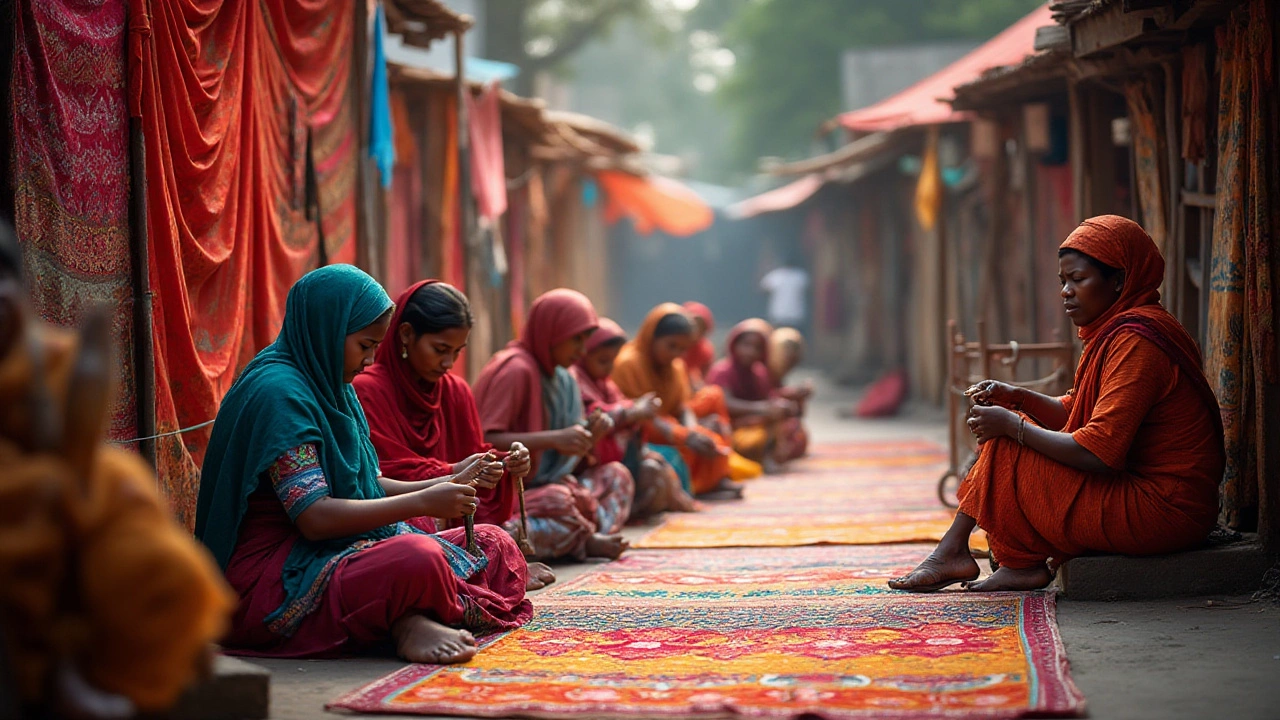 Dec, 31 2024
Dec, 31 2024
India's textile industry stands as a testament to centuries of mastery, earning its title as the 'Queen of Textiles'. A journey through time reveals a landscape interwoven with tradition and innovation, where vibrant saris and intricate embroidery tell tales of cultural heritage.
The thriving industry not only highlights the artistry and stamina of India's workforce but also its crucial role in the nation’s economy. These textiles are more than just products; they are a tapestry of stories, skilled hands, and indomitable spirit.
Delve into the heart of this bustling sector, exploring its historical significance, key players, technological advances, and sustainable practices that future-proof its legacy. India’s textiles are not just commodities; they are the fabric of life.
- Historical Roots of Indian Textiles
- Key Players in the Textile Industry
- Innovations and Technologies
- Economic Impact and Global Reach
- The Role of Sustainable Practices
- Future Trends in Indian Textiles
Historical Roots of Indian Textiles
India's textile history is a rich tapestry that dates back thousands of years. This legacy is deeply ingrained in the culture, making India a pivotal player in textile production since ancient times. The earliest records indicate that the Indus Valley Civilization was already cultivating cotton around 5000 BCE, signifying the inception of textile manufacturing in the region. This period saw the emergence of techniques that would shape the aesthetic and quality of textiles for millennia to come.
During the Maurya and Gupta empires, Indian textiles began gaining recognition beyond the subcontinent, particularly for their vibrant colors and durability. Indian cotton and silk were coveted in the Roman Empire, which viewed these textiles as luxuries. Anecdotes from Roman historians laud India’s goods, with Pliny the Elder calling Indian cotton a 'woven wind' due to its lightness. The trade routes established during these times, like the Silk Road, fostered not just commercial exchanges but cultural ones, embedding Indian textiles into the fabric of other civilizations.
The renowned historian, Romila Thapar, once stated, "The story of Indian textiles is the story of ourselves as a civilization – in color, in artistry, and in global influence."
The Mughal period catalyzed another golden era for Indian textiles. This era drew on Persian aesthetics, creating a unique Indo-Persian style that influenced embroidery and dyeing techniques. Cities like Varanasi became hubs for elaborate brocades, while Bengal thrived on muslin, earning names like 'woven air' for its exceptional quality. The Mughals also invested in artisanal skill enhancement, a legacy visible in the exquisite craftsmanship that persists today.
By the 18th century, India's textile prowess led to an intricate global trade network, with the European East India Companies eagerly participating in the exchange. The British, fascinated by Indian chintz, calicoes, and muslins, began integrating these styles into Western fashion. This period, however, also marked the beginning of adversity as colonial policies slowly strangled indigenous practices. Taxation and trade policies were drafted to favor British-made textiles, leading to the industry's decline during colonization, only for it to resurge post-independence.
Despite such historical upheavals, the roots of Indian textiles remained strong, continuously adapting and evolving. Today's textile industry is a blend of this rich heritage and modern innovation, with India leading the charge in sustainable production, artisanal craft revival, and exporting textiles to the entire world. The resilience and adaptability of the Indian textile tradition are undeniably among the reasons they've held the crown as the queen of textiles for so long. These ancient practices continue to inspire contemporary designs, reflecting a vibrant history that steadfastly embraces its future.
Key Players in the Textile Industry
When delving into the vast fabric of India's textile industry, identifying the key players is akin to mapping out a constellation of stars, each illuminating the sector with its unique brilliance. At the heart of India's textile powerhouse are industry giants like Arvind Limited and Raymond Group, both of which have spun yarns of excellence for decades. Arvind Limited, founded in 1931, has played a pivotal role in positioning India as a leader in the global textile landscape by producing over 100 million meters of denims annually. This substantial production not only feeds into the domestic industry but also forms vital threads of connection with international brands.
Raymond Group, with its reputation for fine fabrics, caters to both high-end and everyday markets. Its influence stretches far and wide, owing to its sustainable practices and innovative approaches. A notable part of Raymond’s legacy is its range of textiles that straddle tradition and modernity with style. The company harnesses advanced technology in its state-of-the-art facilities, ensuring that quality meets demand.
Another contributor making waves in this industry is Vardhman Textiles. Established in 1965, Vardhman has consistently grown by diversifying its range and focusing heavily on cotton yarn and fabric, which are integral to both domestic consumption and exports. The group emphasizes sustainability, recently unveiling measures to cut water consumption in their processes by a significant percentage. India textile manufacturers take pride not only in their product range but also in mitigating the environmental impact of production.
‘The textile industry is the backbone of India's economy,’ remarked a report from the Indian Institute of Management, highlighting both vast employment opportunities and regional development spurred by textile hubs.These key players are more than just businesses; they set benchmarks that ripple through every stitch and seam in the fabric of the industry, catalyzing innovation and expansion. Their contributions underscore why India holds its title as the undisputed queen of textiles.

Innovations and Technologies
India's textile industry has been a cornerstone of the country's economy for ages, and its evolution over time is nothing short of remarkable. As the world races towards modernization, the Indian textile sector has embraced innovation and cutting-edge technologies to remain a global leader. With the advent of advanced machinery, efficient production techniques, and digital transformation, the industry is setting benchmarks not just locally but globally as well. This evolution signifies a fusion of traditional craftsmanship with modern-day brilliance, stepping into a new era where technology plays a pivotal role.
The implementation of AI and machine learning has streamlined production processes significantly. From smart fabric technology to digitally integrated supply chains, every facet of the textile journey has witnessed a digital revolution. Specifically, smart textiles that can regulate temperature or even track health metrics are redefining the realm of fashion and utility fabrics. This is not merely about efficiency; it’s about revolutionizing the user experience and enhancing functionality in daily life.
In spinning mills across the country, automation is being leveraged to improve quality and reduce waste. The utilization of robots and automated machinery in weaving and spinning has resulted in unprecedented levels of precision and efficiency. Additionally, the use of data analytics allows manufacturers to forecast trends and consumer demands better, allowing them to fine-tune their production strategies accordingly. A report from the Textile Ministry suggests that over 80% of major Indian textile players have adopted some form of automation in their operations.
"India's textile industry is not just adapting to technology; it is redefining it," said a leading expert from the National Institute of Design. "With each thread woven with precision, we are stitching together a future of sustainable and intelligent fashion."
Let’s delve into the fabric of sustainability, where technological innovations address environmental concerns. Dyeing processes, which traditionally required vast amounts of water and harmful chemicals, are being revolutionized through zero-liquid discharge technology and organic dyes. Similarly, recycling technology is on the cusp of change, turning waste into new high-quality fabrics. The emphasis on these practices not only preserves our environment but also showcases India's commitment to sustainable textile production.
India textile manufacturers are also exploring graphene, a material known for its strength and conductivity, in fabric development. This sets the stage for further innovations, potentially leading to intelligent clothing that can charge devices or interact with the environment. Such advancements put India at the forefront of textile technology, continuing a lineage of rich, vibrant textiles now infused with technological marvels.
Economic Impact and Global Reach
The textile industry in India is an economic powerhouse. It contributes significantly to the country’s GDP, employing millions of people and generating substantial revenue. In fact, textiles account for about 2% of the GDP and provide over 45 million people with jobs, which highlights its role as one of the largest employment generators in the country. The industry's extensive value chain from heritage craftsmanship to modern-day industrial textiles underpins its dynamism. Known globally for producing a diverse array of products like cotton, silk, jute, and wool, India has positioned itself as a versatile player on the global stage.
The global reach of the Indian textile sector cannot go unnoticed. It plays a pivotal role in trade, exporting approximately 15% of the country’s total exports, welcoming a market presence in over 100 countries. Major export destinations include the United States, European Union, and the Middle East. The Indian government, cognizant of the sector’s potential, has implemented several policies to foster growth. Initiatives such as the Technology Upgradation Fund Scheme have provided a modern boost to traditional practices, keeping Indian textiles competitive globally.
Amidst its global presence, the sector faces challenges like market competition with China and the need for modernization. Interestingly, these challenges offer opportunities for innovation and diversification. “The Indian textile industry must leverage its cultural strengths and adopt sustainable practices to stay ahead in the race,” noted Ritu Kumar, a veteran in Indian fashion designing. Such insights push the industry to adopt sustainable practices, including organic cotton production and water-efficient methods. India has unearthed a fresh gaze on sustainability, helping to maintain a competitive edge while nurturing environmental concerns.
The strides towards sustainability and innovation are shaping the future of India's textile landscape. The emphasis on green technologies not only appeals to eco-conscious consumers but also attracts international investors who are keen on ethical sourcing. Incorporating cutting-edge technologies, like AI in fabric design and automation in production processes, has enhanced productivity and quality control. The compelling narrative of Indian textiles is characterized by their enduring ability to marry tradition with modernity, ensuring resilience against the backdrop of a fickle global market.

The Role of Sustainable Practices
Sustainability in India's textile industry has emerged not just as a trend, but as an essential practice reshaping the future of fashion and manufacturing. As global awareness of environmental impacts grows, Indian textile manufacturers lead in setting standards for eco-friendly processes. The implementation of sustainable methods is primarily driven by a commitment to reducing carbon footprints, conserving water, and using renewable resources.
One major aspect of sustainable practices is the use of organic and natural fibers. Cotton, known for its environmental concerns when grown non-organically, is being replaced with eco-friendlier alternatives. Textiles made from bamboo, hemp, and jute are not only biodegradable but also require far fewer chemical pesticides and fertilizers. India's diverse climate allows for these fibers to be cultivated domestically, reducing the need for importation and its associated carbon emissions.
Recycling and waste management have also become significant parts of Indian textile production. Many manufacturers have adopted closed-loop production systems, a method where water and chemicals are recycled within the process, minimizing waste. This system has proven efficient in saving resources and cutting down pollution levels, as factories aim for zero discharge of hazardous chemicals.
Adoption of Technology
The adaptation of technology plays a crucial role in enhancing sustainable practices. Digital printing, for example, uses less water and energy compared to traditional methods. Automation and smart textiles are also at the forefront, significantly reducing energy consumption while improving production efficiencies. Factories now incorporate solar power and other renewable energy sources, which contribute to a cleaner production process. Estimates suggest that these technologies could cut energy use by 30% in some facilities, providing a substantial environmental payoff."The textile sector holds great potential to lead by example in sustainable development," says Suresh Prabhu, former Union Minister of Commerce and Industry. "By integrating sustainability into its core practices, we can make a significant positive impact on both the environment and the economy."
The industry's efforts align with India's commitment to the Paris Agreement, aiming to reduce greenhouse gas emissions intensity and increase forest cover. Textile associations actively work to ensure their members adhere to environmental regulations and standards, set by both national and international bodies.
Investment in training and research is another area where India is making strides. Educational programs aimed at developing sustainable textile technologies ensure that the next generation of textile engineers and craftsmen are equipped with the knowledge and skills to innovate responsibly. Research institutions throughout India partner with textile companies to develop new eco-friendly technologies and products, keeping the country ahead in the sustainability race.
The role of sustainable practices in India's textile industry illustrates a proactive approach to environment-conscious production. The ongoing commitment to green innovations not only preserves natural resources but also enhances the global image of Indian textiles. It’s a delicate yarn where heritage meets future—a tapestry committed to a greener tomorrow.
Future Trends in Indian Textiles
As we look towards the future, the Indian textile industry is on the brink of transformation with several dynamic trends taking center stage. In a world where sustainability is not just a buzzword but a necessity, Indian manufacturers are increasingly adopting eco-friendly practices. From organic cotton farming to water-efficient dyeing methods, there's an evident shift towards processes that reduce environmental impact. With climate change and resource depletion taking precedence, the focus on sustainable practices is more significant than ever.
The incorporation of technology stands as another noteworthy trend. The embrace of automation and AI is revolutionizing how textiles are produced. Smart manufacturing is helping in reducing costs and improving efficiency. For instance, AI-powered design software is enabling faster ideation and production of new patterns and fabrics, reducing lead times and boosting creativity. Use of blockchain technology offers some fascinating implications for transparency and traceability, allowing consumers to see the origin of their textile products through each step of the supply chain.
"It's vital for our craft to evolve with the world. Adopting technology and sustainability doesn't just promise growth, it ensures preservation." - A leading textile industry analyst once remarked.
Market demands are also becoming diverse. There's a growing appetite for innovation in fabric types and design, driven by the changing lifestyle needs and preferences of a global audience. Material innovation leads to the development of textiles that are smart and functional. For example, fabrics integrated with wearable tech features, such as those monitoring vitals or adapting to different climate conditions, are increasingly gaining popularity.
The rise in India's global textile reach marks another shaping trend. As geopolitical climates shift, India's positioning as a key player in the international market becomes increasingly strategic. An increase in export-friendly policies coupled with the 'Make in India' initiative is bolstering this surge, opening doors for more extensive market penetration globally. Indian textiles are making noteworthy inroads into previously untapped markets.
Finally, we see a renewed emphasis on skill development within the industry. With the evolving demands, there is a nurturing of artisans and craftspeople to hone skills that blend traditional techniques with modern expectations. Programs that focus on upgrading skills act as catalysts in retaining India's rich textile heritage while adapting to the emerging digital age. Together, these trends paint a bright and promising future for Indian textile manufacturers, setting the stage for a great leap forward.